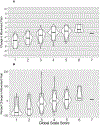Minimal Clinically Important Change of Movement Pain in Musculoskeletal Pain Conditions
- PMID: 38479557
- PMCID: PMC11283950
- DOI: 10.1016/j.jpain.2024.03.003
Minimal Clinically Important Change of Movement Pain in Musculoskeletal Pain Conditions
Abstract
Movement pain, which is distinct from resting pain, is frequently reported by individuals with musculoskeletal pain. There is growing interest in measuring movement pain as a primary outcome in clinical trials, but no minimally clinically important change (MCIC) has been established, limiting interpretations. We analyzed data from 315 participants who participated in previous clinical trials (65 with chronic Achilles tendinopathy; 250 with fibromyalgia) to establish an MCIC for movement pain. A composite movement pain score was defined as the average pain (Numeric Rating Scale: 0-10) during 2 clinically relevant activities. The change in movement pain was calculated as the change in movement pain from pre-intervention to post-intervention. A Global Scale (GS: 1-7) was completed after the intervention on perceived change in health status. Participants were dichotomized into non-responders (GS ≥4) and responders (GS <3). Receiver operating characteristic curves were calculated to determine threshold values and corresponding sensitivity and specificity. We used the Euclidean method to determine the optimal threshold point of the Receiver operating characteristic curve to determine the MCIC. The MCIC for raw change in movement pain was 1.1 (95% confidence interval [CI]: .9-1.6) with a sensitivity of .83 (95% CI: .75-.92) and specificity of .79 (95% CI: .72-.86). For percent change in movement pain the MCIC was 27% (95% CI: 10-44%) with a sensitivity of .79 (95% CI: .70-.88) and a specificity of .82 (95% CI: .72-.90). Establishing an MCIC for movement pain will improve interpretations in clinical practice and research. PERSPECTIVE: A minimal clinically important change (MCIC) of 1.1- points (95% CI: .9-1.6) for movement pain discriminates between responders and non-responders to rehabilitation. This MCIC provides context for interpreting the meaningfulness of improvement in pain specific to movement tasks.
Keywords: Clinical relevance; MIC; Minimal clinically important difference; Movement-evoked pain; Musculoskeletal pain.
Copyright © 2024 United States Association for the Study of Pain, Inc. Published by Elsevier Inc. All rights reserved.
Conflict of interest statement
RLC receives software from Siemens Medical Solutions USA, Inc. Professional and scientific societies have reimbursed her for time and travel costs related to presentation of research on pain and pain education at scientific conferences. LJC receives support for research from Evergreen Pharmaceutical and Argenyx, and receives royalties from Up to Date. Other authors declare no conflicts of interest for this study.
Figures



Similar articles
-
Platelet-rich therapies for musculoskeletal soft tissue injuries.Cochrane Database Syst Rev. 2013 Dec 23;(12):CD010071. doi: 10.1002/14651858.CD010071.pub2. Cochrane Database Syst Rev. 2013. Update in: Cochrane Database Syst Rev. 2014 Apr 29;(4):CD010071. doi: 10.1002/14651858.CD010071.pub3. PMID: 24363098 Updated.
-
Platelet-rich therapies for musculoskeletal soft tissue injuries.Cochrane Database Syst Rev. 2014 Apr 29;2014(4):CD010071. doi: 10.1002/14651858.CD010071.pub3. Cochrane Database Syst Rev. 2014. PMID: 24782334 Free PMC article.
-
Mind and body therapy for fibromyalgia.Cochrane Database Syst Rev. 2015 Apr 9;2015(4):CD001980. doi: 10.1002/14651858.CD001980.pub3. Cochrane Database Syst Rev. 2015. PMID: 25856658 Free PMC article.
-
Transcutaneous electrical nerve stimulation (TENS) for fibromyalgia in adults.Cochrane Database Syst Rev. 2017 Oct 9;10(10):CD012172. doi: 10.1002/14651858.CD012172.pub2. Cochrane Database Syst Rev. 2017. PMID: 28990665 Free PMC article.
-
Yoga for chronic non-specific low back pain.Cochrane Database Syst Rev. 2022 Nov 18;11(11):CD010671. doi: 10.1002/14651858.CD010671.pub3. Cochrane Database Syst Rev. 2022. PMID: 36398843 Free PMC article.
Cited by
-
The effect of the EXOPULSE Mollii Suit on pain and fibromyalgia-related symptoms-A randomized sham-controlled crossover trial.Eur J Pain. 2025 Feb;29(2):e4729. doi: 10.1002/ejp.4729. Epub 2024 Sep 18. Eur J Pain. 2025. PMID: 39291602 Free PMC article. Clinical Trial.
-
Aerobic Exercise Prescription for Pain Reduction in Fibromyalgia: A Systematic Review and Meta-Analysis.Eur J Pain. 2025 Feb;29(2):e4783. doi: 10.1002/ejp.4783. Eur J Pain. 2025. PMID: 39805734 Free PMC article.
-
Achilles tendinopathy.Nat Rev Dis Primers. 2025 Mar 27;11(1):20. doi: 10.1038/s41572-025-00602-9. Nat Rev Dis Primers. 2025. PMID: 40148342 Review.
-
Multimodal Physiotherapist Intervention Program for Physical and Psychological Functioning in Children with Chronic Pain: Guiding Physiotherapy Intervention with the Pediatric Pain Screening Tool with Recommendations for Clinical Practice.J Clin Med. 2025 May 22;14(11):3629. doi: 10.3390/jcm14113629. J Clin Med. 2025. PMID: 40507390 Free PMC article.
References
-
- Beurskens AJHM, de Vet HCW, Köke AJA: Responsiveness of functional status in low back pain: a comparison of different instruments. Pain. 65:71–76, 1996 - PubMed
MeSH terms
Grants and funding
LinkOut - more resources
Full Text Sources

